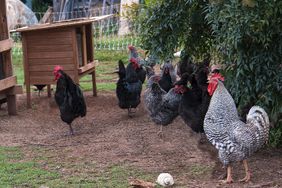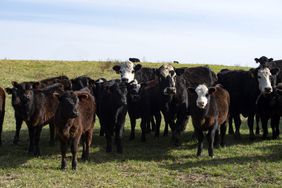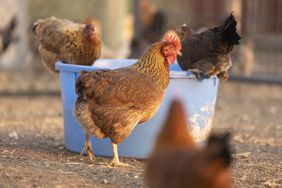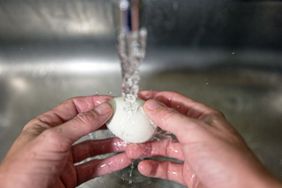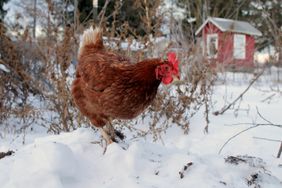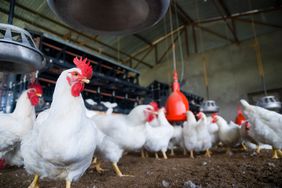:max_bytes(150000):strip_icc()/Chickens-fenced-yard-coop102326227-2-2000-b3a7f32b8b8544718bbf31b74574c957.jpg)
These ideas, written by readers, may just help you keep your chickens and poultry animals (or eggs) safe on the farm.
Chick pen
:max_bytes(150000):strip_icc()/101875324chickpen-3393917f1cb84396b3f2c7b2ced2323f.jpeg)
All Around the Homestead
I get baby chicks in May every year. I keep them in a baby playpen until they are large enough to go in and out of the henhouse. I hose the playpen out to clean it. You can find the playpens at yard sales for $10.
– Kathy Young, West Virginia
Chicken feeder
:max_bytes(150000):strip_icc()/100682024chickenfeeder-c2dff543f50242018a7de0be7bae9cec.jpeg)
Living the Country Life
To create a chicken feeder, cut the bottoms out of a 5-gallon and a 3-gallon bucket. Screw the long side of an L bracket to the 3-gallon bucket leaving 1 inch of the bracket below the bottom of the bucket. Screw the bracket bottom to the 5-gallon bucket.
–C.C., North Carolina
Easter eggs
:max_bytes(150000):strip_icc()/easter-eggs-56ef1d125f9b5867a1c45dc1.jpg)
I have finally found a way to make my chickens stop pecking their eggs. I fill old plastic Easter eggs with chicken manure and place them around the chicken coop. Whenever a chicken pecks at one, they get a nasty surprise.
–A.D., West Virginia
Discarded Easter eggs
:max_bytes(150000):strip_icc()/172130422-56a7788c3df78cf772963a45.jpg)
We put one plastic Easter egg in each of our chickens’ nesting boxes. It encourages the hens to use all the boxes, and when the snakes come to eat the eggs, they get a surprise.
–R.I., Missouri
Coops and ladders
:max_bytes(150000):strip_icc()/101921311coopandladders-7b1f39bc2aeb475d9177eaaa2d593f13.jpeg)
Living the Country Life
I built a roost for the coop with a section of wood ladder. It attaches to the wall with two chains and two hinges so it swings up when cleaning. A screen door hook is mounted to the wall to hold the ladder.
– Jay Betemps, Ohio
Hawk deterrent
:max_bytes(150000):strip_icc()/101953368hawkdeterrent-2ecc2ac4cae44cfabb3b0b4ac10b3030.jpeg)
Living the Country Life
To keep hawks from attacking my chickens, I used 50-pound test fishing line, weaving it back and forth across the top of the enclosure 3 to 4 inches apart. The reflective line is a deterrent. Haven’t lost a bird since.
– Virginia Weir, Missouri
Try pie pans
:max_bytes(150000):strip_icc()/102058433trypiepans-f10602e92ee94ca4a5ddda863df3d4f8.jpeg)
Living the Country Life
I saw two hawks land high in a tree the first day I turned my chickens loose on my 2-acre yard. Because hawks are afraid of anything moving, I hung alu-minum pie pans on baling twine from trees. The pans glisten and swing with the wind. I haven’t lost a chicken, and I haven’t seen any hawks since. The chickens also keep my yard free from moles and ground squirrels.
– Phyllis Poole, Indiana
Portable chicken house
:max_bytes(150000):strip_icc()/portablechickenhouse-b3c4ca0bf9504d4188d7e13459558005.jpg)
Living the Country Life
I used half of a wagon that my father bought from Sears in the late 1950s to build a chicken house. The side boards are off of a loading chute, the door was made out of boards from old gates, and the roof was tin left over from when I sided my shed.
– R.C., Illinois
Keep chickens from roosting
:max_bytes(150000):strip_icc()/chickenroosting-f0d05125db1a480b951828bfbc97d9ad.jpg)
Living the Country Life
A great way to keep chickens from perching on standard galvanized poultry cans is to place a ring of chicken wire over the top of the can. The chickens may try to stand on it and it will bend down, but the wire is easily bent back in shape.
– J.H., Michigan
Preventing canine attacks
:max_bytes(150000):strip_icc()/protect-your-chickens-from-predators-3016834-04-f6d5a1a3e5034811bc5b6f0ab2ad8693.jpg)
The Spruce / Charlotte Engelsen
To prevent canine attacks, I painted a 1-inch stripe of syrup of ipecac on the backs and tails of my chickens to repel the predators. I haven’t lost a bird in over a year!
– F.H., Virginia
Chicken parasite treatment
Let chickens treat themselves for external parasites. Provide a wooden box filled with clean sand so the birds can dust themselves. Add an appropriate amount of Sevin Dust and mix well.
– J.B., Oklahoma
